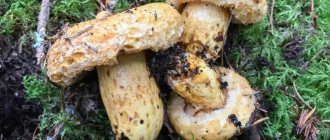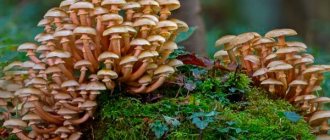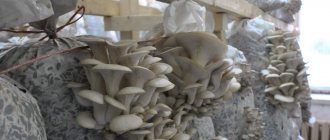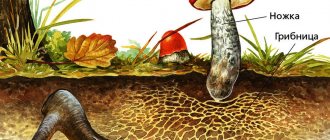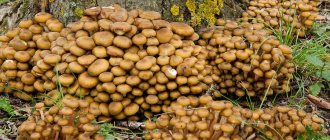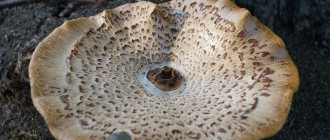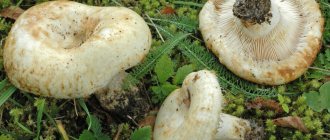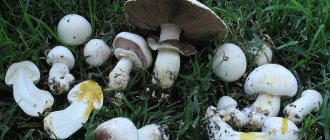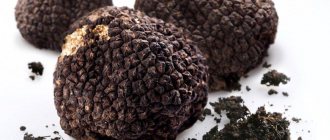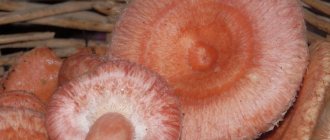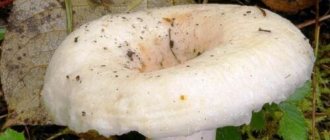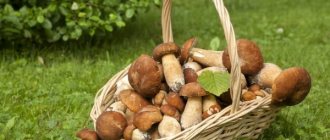Milk mushrooms are representatives of the Russulaceae (Russula) family, the genus Lactiferae (which means that when the fruiting body, which has increased fragility, is broken, milky juice flows out) and the lamellar order. In European countries, all varieties of milk mushrooms are considered inedible due to their bitter taste, and some classify them as poisonous mushrooms, but in Rus' it has always been the “king” of mushrooms. They are classified as conditionally edible and inedible species.
Description of appearance
The cap in all species is fleshy, usually up to 7-10 cm in size, less often up to 20 cm. Initially, it is flat with a depressed center and curled shaggy edges. Later it takes the shape of a “funnel”. The skin of the mushroom is slimy and sticky, with rare exceptions. Therefore, it is often covered with needles, blades of grass and other natural debris. The leg is hollow inside, smooth. In some species it thickens towards the bottom.
In all types of milk mushrooms, white milky juice appears at the break; in the air, it instantly curls up and changes its color. For some varieties this is a characteristic feature by which they are identified. The juice usually tastes bitter or acrid. The greater the pungency, the more time it takes to pre-treat the mushrooms - soaking.
Nutritional value of milk mushrooms
100 g of raw mushroom contains:
- protein - 1.8 g;
- fats - 0.8 g;
- carbohydrates - 1.1 g;
- fiber - 1.5;
- ash - 0.4 g;
- water - 88 g.
The energy value of 100 g of mushroom is only 18.8 kcal.
Mushrooms are rich in B vitamins - thiamine (B1), riboflavin (B2), ascorbic acid (C), and contain a small concentration of nicotinic acid (vitamin PP). But in terms of mineral composition, milk mushrooms occupy the last position among other mushrooms, since they practically do not contain macro- and microelements.
Where to find mushrooms?
Each milk mushroom has its own preferences for soils and forests, so their distribution area is large. They are collected throughout the European part of Russia, in the south of the country; mushroom pickers of the Volga region, Transbaikalia, Siberia, the Urals and the Far East are not deprived of them. In every locality, one or another milk mushroom is found; in some areas, milk mushroom is widely represented by various species. Some species live only in oak forests, others - in birch forests, coniferous or deciduous forests. But they all love well-moistened soils. Therefore, if you go into the forest, and there is dry or sandy soil, then you will not find milk mushrooms in it. They usually go on a “quiet hunt” for milk mushrooms in July – September.
Story
Throughout its history, the flag of Andorra has undergone several changes.
First image
1806 – 1866 – the first national flag of the principality was in use. It looks like this: a rectangular canvas divided vertically into two halves - yellow and red. This was the first canvas of the county of Foix.
Three-way
1866-1878 – the panel becomes three-stripe: a third – blue – is added to the two existing stripes. This was done by the French Emperor Napoleon III to reflect the rights of the French to this territory, because France acted along with Spain as co-ruler of Andorra. Thus, the yellow-red colors reflect the political interests of the Spaniards in this region, and the blue-red stripes present in the French tricolor reflect the interests of the French state.
Adding a coat of arms
1878-1934 - during this period, a coat of arms was added to the image. This is a forced measure, recognized to distinguish the flag of Andorra from the United Principality of Wallachia and Moldavia, and later from Romania, since Romania was officially recognized by the European community and had exactly the same flag as the Pyrenean principality.
The coat of arms on the cloth is four-part, in the Spanish version:
- In the first quarter there is a golden miter and a bishop's staff on a scarlet field.
- In the second and third quarters there are red vertical stripes on a golden background (three in the second and four in the third).
- In the last, fourth part, there are two scarlet bulls with azure bells on their necks. Located one above the other, on the golden background of the shield.
- The motto in Latin at the bottom of the shield is Virtvs Vnita Fortior (translated: “Together we are stronger!”).
Under Boris I
1934-1948 – Andorra was represented by the so-called Skosyrev flag. In 1934, Russian emigrant Boris Skosyrev became King of Andorra for two weeks. During his reign of the kingdom, he managed to change the flag, which received the following appearance: three equal horizontal stripes, the top one is red, the middle one is yellow, the bottom one is blue. In the center of the yellow stripe is the French count's crown. This version of the image serves as one of the state flags of Andorra (its Spanish version).
Varieties
There are several varieties of milk mushrooms, among them there are similar ones, so it is very important to correctly distinguish them from each other:
Real milk mushroom
The most valuable representative of this family. In different regions it has its own name - milk mushroom raw or white, pravsky or wet, white milk. The name reflects the main feature of the mushroom, by which it is easily recognized - the milky white color of the cap, which resembles marble. And also an equally remarkable feature is the fluffy fringe, which is located along the edges of the cap.
Milk mushrooms can vary in size. In some, the cap reaches 25 cm in diameter, in others it grows up to 9 cm. The mushroom stands on a small, cylindrical and smooth stalk, which is painted white or yellowish. The pulp has a fruity odor; the milky juice turns yellow when exposed to air. He prefers to settle in birch groves, less often in mixed forests. Distributed throughout Russia, appears from early June to September, in the southern regions - August-September.
Parchment and pepper breast
They are very similar to each other in appearance. Both of them belong to conditionally edible, low-grade mushrooms. They can be easily distinguished by the “behavior” of the milky juice in the air. In the parchment mushroom it does not change its color, but in the pepper mushroom it instantly turns blue. In addition, when you cut a pepper milk mushroom, you can see the same metamorphosis with its flesh; it acquires a blue-blue color.
The caps of young mushrooms are flat, slightly convex, and over time they take the shape of a “funnel.” And its white color gradually disappears and gives way to a yellow tint. They are also distinguished by the height of the stem - in the parchment mushroom it is longer (10 cm versus 6 cm) and narrowed downward.
These species appear at the same time in summer and autumn, preferring mixed forests. However, the peak collection occurs in August - September. Pepper mushroom is more often found in birch-oak groves on well-drained clay soils in the middle zone, parchment mushroom - in mixed forests and conifers.
Yellow milk mushroom
It grows in the northern regions and has a remarkable appearance. The local population also calls it a wave or a scraper. In search of it, they go to a fir forest or spruce forest; occasionally, with great luck, it is found in mixed forests. These bright yellow mushrooms with 10-centimeter caps are clearly visible under dark plant litter. However, there are also record-breaking giants whose caps grow to 28-30 cm.
The cap is covered with hairs and is very slimy. The leg is short, strong and the same color as the cap. When you press it, the flesh darkens. The milky sap reacts with air to become yellowish and smells slightly like fruit.
Canine or blue breast
This conditionally edible mushroom has not found much popularity among mushroom pickers. It is often classified as a toadstool and passed by. Perhaps due to the fact that milk mushrooms usually grow in families, but this variety prefers to grow in splendid isolation. You can find it in damp places under willows and birches. The yellow cap is covered with villi, and the milky juice turns purple or lilac when exposed to air. The mushroom lives up to its name when you press the flesh. At the point of pressure, a “bruise” appears on the white surface.
Milk mushroom is bluish
"Meteor dependent" edible mushroom. Weather conditions greatly influence its taste. The velvety white funnel cap can be seen on calcareous soils in deciduous forests. The milky sap very quickly coagulates in air and turns green. The pulp also turns green when cut and smells pleasantly with a woody-honey aroma.
Swamp milk mushroom
The marsh milk mushroom grows in groups, preferring lowlands and soils with high humidity. It is collected from the beginning of summer until the end of autumn. The reddish caps with a tubercle in the center fade over time to a yellow-brown color. The leg is long, covered with fluff. The milky sap turns yellow when exposed to air.
Red milkweed, milkweed or red milk mushroom
Unlike its “brothers,” the rubella has a dry orange-brown cap covered with cracks. The milky juice of this mushroom has a sweetish taste; when exposed to air, it quickly turns brown and becomes viscous, reminiscent of molasses. This rare species is found in coniferous or deciduous forests from July to October.
Watery zone milk mushroom
This milk mushroom has furry, curled cap edges. It grows very densely. The surface of the cap is covered with a small amount of mucus. The older the mushroom, the more funnel-shaped it takes. The pulp has a strong pleasant aroma. Milky sap quickly turns yellow in air. Quite often this type of milk mushroom is confused with white milk mushroom, although it is much larger in size than its “double”, dry milk mushroom and violin. The latter are similar in appearance, but the former does not have milky juice, and the latter lacks hairy edges.
Frying yellow-brown rows
Frying mushrooms is a completely simple process, especially since the recipe for making yellow-brown row does not require expensive ingredients. However, you and your household will be able to enjoy the amazing taste and aroma of the dish.
- 1 kg of rows;
- 300 g onions;
- 150 ml vegetable oil;
- 300 g sour cream;
- 1 tsp. paprika;
- 1/3 tsp. ground black pepper;
- 50 g chopped parsley;
- Salt - to taste.
- Clean the rows, cut off the tip of the stem, wash and cut into pieces.
- Boil in salted water for 15 minutes, regularly skimming the foam from the surface.
- Drain the water, add a new portion and cook for another 30 minutes.
- While the rows are cooking, peel the onion, cut into half rings and fry until soft over low heat.
- Place the boiled mushrooms in a colander, drain and fry in a separate frying pan for 30 minutes.
- Combine with onion, salt, add pepper and paprika, mix.
- Fry for 10 minutes over low heat and add sour cream. It is better to beat sour cream with 1 tbsp. l. flour so that it does not curl.
- Continue simmering over low heat for 10 minutes.
- Before serving, sprinkle the fried rows with chopped parsley.
| Name: | Row yellow-red |
| Latin name: | Tricholomopsis rutilans |
| Type: | Conditionally edible |
| Synonyms: | Blushing row, Yellow-red false row, Yellow-red honey fungus, Red honey fungus, Pine honey fungus, Cortinellus rutilans |
| Characteristics: |
|
| Taxonomy: |
|
The yellow-red row is a representative of agaric mushrooms that grow in Russia. It is distinguished by the bright color of its cap.
Eat with caution, only after heat treatment
Benefits of mushroom
Milk mushrooms are rich in protein, so they are often used by vegetarians. In addition, plant protein is better absorbed by the body. They remove waste, toxins, cholesterol from the body, and prevent blockage of blood vessels. Facilitate the progression of tuberculosis and urolithiasis.
Pepper milk has a negative effect on the development of tuberculosis bacillus, inhibiting it. An extract that has antifungal and antibacterial properties is made from this species.
Experts believe that when salting milk mushrooms, chemical compounds are formed that help fight inflammatory processes and sclerosis.
Preparation and storage
Most of all, these mushrooms are salted. To do this, after the mushrooms are cleaned and soaked, they are washed again. Then they start salting. Currant, cherry, horseradish leaves and dill umbrellas are placed at the bottom of the tub or pan. Then add a layer of milk mushrooms and sprinkle with salt. Then the next layer, and so on until the container is full. A fragrant mixture of horseradish leaves, dill umbrellas, cherry leaves and currants is again placed on top. Press down with pressure and allow to salt. In just a week you can try this masterpiece.
Store at a temperature of +5 degrees. You cannot keep them in the cold, because after freezing they become soft and lose their taste.
How to collect milk mushrooms?
Mushrooms love to hide under fallen leaves and pine needles. Therefore, when going on a “quiet” hunt, be sure to take a stick. It will be convenient for her to clear away natural debris. In addition, experienced mushroom pickers can find a place with mushrooms by smell, since milk mushrooms are fragrant from a distance. Mushrooms are looked for in short grass, the stem is carefully cut off with a knife. Having found one mushroom, be sure to thoroughly scan the area nearby.
Unfortunately, milk mushrooms have poisonous counterparts that are dangerous to humans. If there are doubts about the suitability of a mushroom for food, it is not cut off, but left in place. Black mushroom also contains toxic substances. But with proper heat treatment and soaking, the mushroom becomes harmless.
What mushrooms can milk mushrooms be confused with?
It is difficult to confuse milk mushrooms, despite the numerous varieties. But still, they have a couple of doubles, some of which can be poisoned.
- The first double is the violin. It is significantly inferior in nutritional quality to real milk mushrooms, but is edible. It is easy for an attentive mushroom picker to distinguish between these two species. The violin has no fringe along the edge of the cap, the plates are denser and thicker, and in comparison with the color of the cap they are darker. If doubts still remain, then the behavior of the milky juice will dot the i’s. On a violin, when exposed to air, it does not change color immediately, but after a long time. When the juice dries up, it turns red; in milk mushrooms, the juice changes instantly. The remaining doubles are inedible mushrooms that, when consumed, cause poisoning, as they accumulate a large amount of toxins. Camphor and golden yellow milk mushrooms are similar to milk mushrooms.
- Camphor milkweed at a young age has a strong specific unpleasant odor, reminiscent of camphor, over time it gives way to a light coconut aroma. The red cap grows up to 12 cm, the edge of the cap dries out, falls down and becomes covered with scales. The fungus grows on acidic coniferous soils and prefers rotting litter or wood.
- The yellow-golden milkweed grows under chestnuts and oaks. The convex cap gradually takes on a depressed shape. The cap is covered with dark spots, while milk mushrooms usually have rings. The milky sap quickly turns yellow in air. In some sources it is classified as a poisonous mushroom.
All the words (anagrams) that can be made from the word "bright golden yellow"
- Word search
- Make up words
- Words from the word "bright golden yellow"
In total, you can make 461 noun words from 2, 3, 4, 5, 6, 7, 8, 9, 10, 11 letters.
2 letter words made from bright golden yellow (16 words):
3 letter words made from bright golden yellow (71 words):
- fat
- zhor
- convict
- z
- zil
- evil
- language
- X
- ict
- iol
- lawsuit
- yot
- cue
- keel
- whale
- count
- cat
- lei
- lek
- forest
- years
- lei
- face
- fox
- ENT
- lot
- eye
- ors
- ort
- osk
- ost
- res
- ray
- Rhea
- rice
- Roy
- rock
- roll
- mouth
- roar
- ryazh
- this
- this
- set
- this
- sire
- juice
- rubbish
- hundred
- soybeans
- one hundred
- cheese
- tech
- tes
- teak
- shooting gallery
- yew
- aphid
- that
- current
- tol
- torus
- That
- rear
- cord
- jarl
- eras
- others like it
- iso
- xi
- three
Anagrams. 4 letter words made from bright golden yellow (113 words):
- hedgehog
- Eric
- rod
- gesture
- lived
- lively
- very much
- evil
- Zoyl
- dawn
- ikos
- helot
- irey
- case
- icon case
- glue
- Claire
- clergy
- clot
- coir
- cake
- court
- Croesus
- crisis
- Chris
- cut
- mole
- kryzh
- rats
- ridge
- summer
- sheet
- liter
- bed
- gloss
- bast
- lambing
- eagle
- orok
- misfired
- donkey
- mastered it
- sow thistle
- edema
- calving
- otitis
- flight
- risk
- riyal
- swarms
- roll
- role
- height
- snout
- yaw
- growls
- village
- Sickle
- force
- sieve
- monastery
- chipped
- livestock
- rally
- layer
- variety
- slice
- term
- stack
- erased
- drain
- table
- joint
- cheese
- tex
- body
- calf
- test
- aunt
- thyrsus
- titer
- sense
- torque
- torso
- cake
- toast
- track
- trok
- cable
- trot
- tongue
- language
- skiff
- bright
- giro
- zero
- kilo
- clio
- colo
- liro
- loco
- lori
- loro
- lotto
- Oriya
- rock
- pre-trial detention center
- solo
- sauté
- soti
- dash
- Tory
- trio
5 letter words made from bright golden yellow (121 words):
- vent
- vest
- residential
- fat
- fat guy
- jockey
- zealot
- son-in-law
- son-in-law
- flight
- sophistication
- source
- pouch
- muslin
- crossbill
- goat
- coyote
- color
- stabs
- track
- colitis
- ear
- oblique
- boiler
- Creole
- cross
- wing
- kariz
- forest
- entrance
- Lysol
- liquor
- lily
- letters
- spoons
- tray
- lotus
- lake
- oirot
- birth
- octet
- oolite
- halo
- orlik
- bracken
- orthitis
- sturgeon
- donkey
- donkey
- osteitis
- ostol
- Ostyak
- otzol
- spall
- slope
- departure
- cut
- youth
- compartment
- swelling
- outflow
- resit
- resol
- release
- relit
- horn
- rumble
- video clip
- mouth
- rotok
- redhead
- ginger
- saffron milk cap
- series
- serco
- grey
- sizok
- sissyak
- sycosis
- snare
- raw
- skate
- slimy
- soyot
- falcon
- salty
- solarium
- litters
- fourty
- hundredth
- path
- stoic
- riser
- swift
- streak
- straight
- build
- cheese
- siazhok
- thesis
- theist
- text
- telly
- upskirt
- adze
- dough
- title
- tholos
- thorium
- thorite
- hummock
- crack
- trust
- triple
- tyrlo
- label
- yastyk
- collie
- citro
- stylo
- tights
6 letter words made from bright golden yellow (81 words):
- yolk
- yellow
- yolk
- gesture
- jet
- zhoster
- zloty
- gold
- isolate
- Iroquois
- killer
- sour
- choir
- clitoris
- closet
- wheel
- college
- corset
- motorcade
- Cortes
- trough
- church
- bonfire
- cresol
- armchair
- xerosis
- xylene
- ktitor
- leukemia
- lecturer
- lictor
- leaf
- little lake
- oxide
- about okoliya
- touchstone
- osilok
- osteitis
- tip
- wit
- otolith
- youth
- sucks
- imprint
- Rexit
- relic
- wanted
- sprout
- sector
- Scolia
- chipped
- fast
- fledgling
- ingot
- salty
- cut
- hiding
- stitch
- glass
- stylet
- styrene
- stack
- stall
- stoker
- table
- carpenter
- watchman
- tektite
- theorist
- theory
- terlik
- test
- tetryl
- thiokol
- cake
- toaster
- third
- cable
- TNT
- jarosite
- Othello
7 letter words made from bright golden yellow:
- gold
- gold
- Coliseum
- coloring
- coterie
- creosol
- creosote
- rabbitist
- lyktros
- litorrhea
- litotes
- osteria
- remnant
- line segment
- spur
- seclusion
- shooting
- mouthy
- royalist
- scleritis
- sclerosis
- scoliosis
- hiding
- tapeworm
- solarium
- stellite
- chatter
- shooter
- haircut
- thick
- fat man
- triolet
- trolls
- canes
- risotto
- stretto
8 letter words made from bright golden yellow:
- insulator
- colorist
- pounded
- cortisol
- bone cutter
- lecture hall
- lecture hall
- leaf cutter
- spoon cutter
- ozokerite
- prison
- opening
- shoot
- concealment
- gatehouse
- Troostitis
9 letter words made from bright golden yellow:
textolite
10 letter words made from bright golden yellow:
- yellowthroat
- yellowmouth
- otosclerosis
11 letter words made from bright golden yellow:
- thick-skinned
- bighorned
Queries that may be of interest:
- Words starting with "t"
- Words with "th" at the end
- Words starting with "that"
- Words ending with "i"
- Words starting with "tol"
- Words ending with "live"
- Words that start with "tols"
- Words ending with "oh"
- Make words from the word "thick-skinned"
How to grow milk mushrooms yourself?
Milk mushrooms are grown at home in two ways:
- From purchased mycelium - it is placed in a prepared substrate. The first harvest is harvested after a year, the mycelium pleases with mushrooms for 5 years.
- From independently collected spores , mycelium is first grown from them, and then only planted. The cost method is more economical than the first, but the result is unpredictable. Since it is difficult to grow mycelium from spores on your own.
Preparing for sowing
First, select a site for the mycelium. Young trees should grow on it - birch, willow, poplar, hazel, whose age does not exceed 4 years. It should also be protected from direct sunlight. The soil is disinfected using a lime solution (50 g of lime is dissolved in 10 liters of water), spilling it, and fertilized with peat.
Prepare the substrate. It consists:
- from sterilized sawdust (they are boiled down);
- disinfected soil;
- from forest moss and fallen leaves. They are collected from places where milk mushrooms grow.
Sowing of seed material is carried out in open ground from May to October. When grown indoors, mycelium is planted year-round.
Sowing
In the area near the roots of the trees, dig holes and fill them halfway with the prepared substrate. The mycelium is distributed over the entire surface and the hole is completely filled. The earth is compacted and covered with fallen leaves and moss.
In the room, the prepared substrate is mixed with mycelium and filled into bags, on which cuts are made in a checkerboard pattern.
After planting, the plantation is regularly watered. In hot weather, at least 30 liters of water are poured under each tree. For the winter, the myceliums are covered with leaves and moss.
The temperature in the room is first maintained at +20 C, as soon as the first sprouts of mushrooms appear, it is reduced to +15 C. The mushrooms are provided with good lighting and humidity of 90-95%.
So, milk mushrooms are considered valuable commercial mushrooms. They are used not only for cooking, but are also used in folk medicine. Extracts and elixirs are made from them, using young mushrooms for these purposes. Some healers use milky juice to remove warts.
0
0
Copy link
